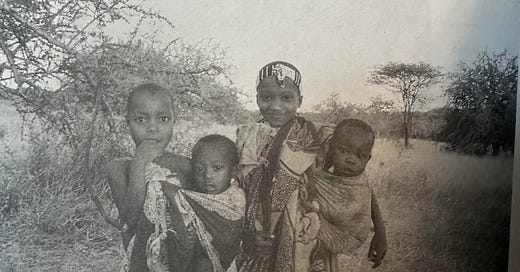Kids caring for kids has a 300,000-year history
But is it parentification or critical skill-building?
Last weekend I published my tongue-in-cheek piece on the 30-Day-Tradwife Challenge and holy mackerel what a shitstorm that was! I broke all of my personal Substack records in terms of reads, subscriptions, engagement and…backlash. I am not going to say much about it except that it seems we are no longer allowed to use sarcasm in writing, or explore nuance in opposing perspectives, without being taken to town for it by the mobs.
Since the tradwives were such a hit last time, let’s talk about another aspect of tradwifing that tends to generate a healthy load of controversy: enlisting the older children to help care for the younger ones. Remember that famous Times piece that kicked off the whole Ballerina Farm debate? Here is something the reporter wrote that really stuck with me: “The children appear to look after each other quite well…there are so many that they seem to have become an almost self-sustaining entity.”
I think one thing people do not appreciate about Hannah Neeleman’s situation is that she has built-in childcare. That same article famously explained that her husband allows no paid childcare in the home (which was rightfully one of the more hot-button issues in the piece. I mean, why, for heaven’s sake, when you are richer than God, would you deny yourself the benefit of a nanny or two?) But the thing is, they have created their own multi-age playgroup, and this is a non-negligible factor! You’ll notice that Hannah doesn’t have any content from when she had two under two, or three under five, probably because she couldn’t! Having watched the way my son will integrate into a larger group of children at the playground (especially when kids over the age of 6 or 7 are involved) and require nothing from me for hours, I can imagine how Neeleman’s life as a parent, at this stage, might actually be easier in some ways than mine. My own grandmother was the 12th of 13, raised on a farm, and mostly cared for by her older siblings.
Hadza girls look after their younger siblings
Like it or not, kids raising kids has a 300,000-year history. In hunter-gatherer societies, some of the most helpful “alloparents” (non-maternal caregivers) are children between the ages of 6 and 11. After a child is weaned in hunter-gatherer society, he or she will begin spending more and more of their time in a multi-age playgroup, where they often receive informal care and supervision from the older children. Although adolescents also participate in playgroups, they tend to be less helpful than the 6 to 11-year-olds. (An American teacher I know, who supervises a mixed-age after-school program, told me, “the teens are just too busy flirting”).
But when we talk about kids raising kids in the modern context, it often devolves into a shouting match about the risks of parentification. Are these concerns valid? How is Ballerina Farm’s model different from our evolutionary past and is one model more concerning than the other? Let’s dive into some of the evidence and nuance.
Keep reading with a 7-day free trial
Subscribe to MOTHERHOOD UNTIL YESTERDAY to keep reading this post and get 7 days of free access to the full post archives.




